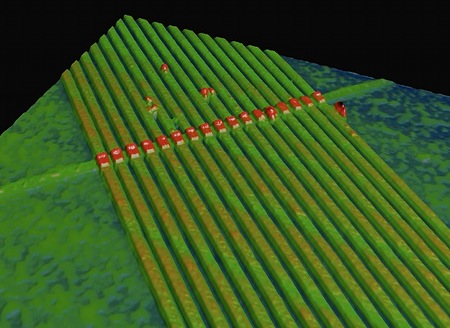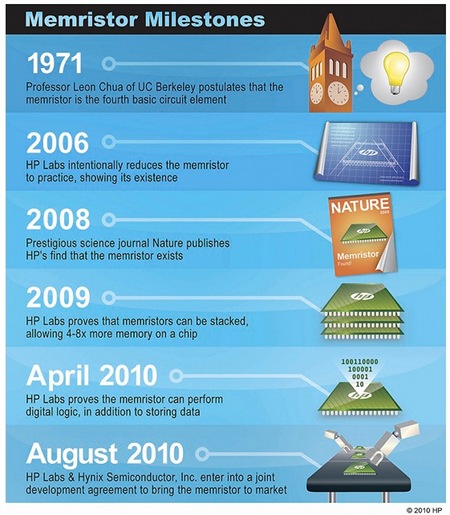HP and Hynix team up on ReRAM
Sep 2, 2010 — by LinuxDevices Staff — from the LinuxDevices Archive — 6 viewsHP and Hynix Semiconductor announced they've entered into a joint development agreement on a memristor technology called ReRAM, claimed to be up to 100 times faster than flash memory while using 1/10th the energy. ReRAM devices could start replacing random access memory (RAM) and flash within three years, and may eventually replace CPUs, too, say the companies.
HP and Hynix say that, together, they'll put in place the necessary materials and processes to commercially develop the memristor technology, and the technology — which is being developed as ReRAM (Resistive Random Access Memory) — will be manufactured in Hynix's fabs.

An image of a microscopic circuit with 17 memristors
Source: HP
(Click to enlarge)
The result, according to HP officials, is a technology that will perform better than the current flash technology found on such devices as mobile handsets. It will be 100 times faster, significantly smaller, and consume a 10th of the energy, they add.
"This is going to change the memory industry," Stan Williams, an HP Senior Fellow and founding director of the Information and Quantum Systems Lab, said in a video (embedded at the end of this story) on the HP Website. "This is going to allow us to continue scaling — in other words, go to higher and higher densities — as [the industry did] with flash, but actually with a product that has the capability and capacity, we all believe, to replace both hard disks and DRAM memory in computers."
The memristor — short for memory resistor — is viewed by HP engineers as the fourth basic circuit element in chip engineering, up there with resistors, capacitators and inductors. At its core, the memristor is a resistor with memory.
The idea behind the memristor was first broached in 1971 by Prof. Leon Chua at the University of California Berkeley. HP researchers first reduced the memristor to practice, showing its existence.
Two years later, the journal Nature published the company's finding that the memristor exists, and in 2009, engineers at HP Labs showed that memristors could be stacked, suggesting that a chip could offer four to eight times the memory capacity of traditional technologies.
In April, HP officials said company researchers found that the memristor also could perform digital logic, setting the stage for the creation of a memristor product that could act as both a computing chip and as a storage technology, taking the place of traditional storage technologies — including flash and hard drives — and CPUs.

A history of memristor research
Source: HP
(Click to enlarge)
"Memristive devices could change the standard paradigm of computing by enabling calculations to be performed in the chips where data is stored," Williams said in April. "Thus, we anticipate the ability to make more compact and power-efficient computing systems well into the future, even after it is no longer possible to make transistors smaller via the traditional Moore's Law approach."
Memristor technology is a form of nonvolatile memory that HP officials believe will be able to be used in everything from mobile phones and MP3 players, which primarily use NAND flash memory now, and as a replacement for storage technology such as SSD (solid-state disk) and DRAM.
Memristors, which not only use less energy than other memory devices and can retain information when the power if off, are built from metal oxides like titanium dioxide, rather than silicon.
"The memristor has storage capacity abilities many times greater than what competing technologies offer," S.W. Park, executive vice president and CTO at Hynix, said in a statement. "By adopting HP's memristor technology, we can deliver new, energy-efficient products to our customers more quickly."
HP's Stan Williams on memristors
(click to play)
Further information
For background information on HP's work with memristors, see a detailed article by eWEEK's Chris Preimesberger, here. A blog entry announcing the joint development agreement with Hynix may be found here.
Jeffrey Burt is a writer for our sister publication eWEEK.
This article was originally published on LinuxDevices.com and has been donated to the open source community by QuinStreet Inc. Please visit LinuxToday.com for up-to-date news and articles about Linux and open source.